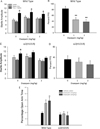α2-containing GABA(A) receptors: a target for the development of novel treatment strategies for CNS disorders
- PMID: 22921455
- PMCID: PMC3478960
- DOI: 10.1016/j.pharmthera.2012.08.006
α2-containing GABA(A) receptors: a target for the development of novel treatment strategies for CNS disorders
Abstract
GABA(A) receptors have important physiological functions, as revealed by pharmacological studies and experiments involving gene-targeted mouse models, and are the target of widely used drugs such as the benzodiazepines. In this review, we are summarizing current knowledge about the function of α2-containing GABA(A) receptors, a receptor subtype representing approximately 15-20% of all GABA(A) receptors. This receptor subtype mediates anxiolytic-like, reward-enhancing, and antihyperalgesic actions of diazepam, and has antidepressant-like properties. Secondary insufficiency of α2-containing GABA(A) receptors has been postulated to play a role in the pathogenesis of schizophrenia, and may be involved in cognitive impairment in other disorders. Moreover, polymorphisms in the GABRA2 gene encoding the GABA(A) receptor α2 subunit have been found to be linked to chronic alcohol dependence and to polydrug abuse. Thus, α2-containing GABA(A) receptors are involved in the regulation and/or modulation of emotional behaviors and of chronic pain, and appear to be a valid target for novel therapeutic approaches for the treatment of anxiety, depression, schizophrenia and chronic pain.
Copyright © 2012 Elsevier Inc. All rights reserved.
Conflict of interest statement
Conflict of Interest Statement:
"In the last three years, UR has provided professional services for Sunovion and for Concert Pharmaceuticals. JL and EE declare that they have no conflict of interest."
Figures




References
-
- Agrawal A, Edenberg HJ, Foroud T, Bierut LJ, Dunne G, Hinrichs AL, Nurnberger JI, Crowe R, Kuperman S, Schuckit MA, Begleiter H, Porjesz B, Dick DM. Association of GABRA2 with drug dependence in the collaborative study of the genetics of alcoholism sample. Behavior Genetics. 2006;36:640–650. - PubMed
-
- Agrawal A, Pergadia ML, Saccone SF, Hinrichs AL, Lessov-Schlaggar CN, Saccone NL, Neuman RJ, Breslau N, Johnson E, Hatsukami D, Montgomery GW, Heath AC, Martin NG, Goate AM, Rice JP, Bierut LJ, Madden PA. Gamma-aminobutyric acid receptor genes and nicotine dependence: evidence for association from a case-control study. Addiction. 2008;103:1027–1038. - PubMed
-
- Amsterdam JD, Kaplan M, Potter L, Bloom L, Rickels K. Adinazolam, a new triazolobenzodiazepine, and imipramine in the treatment of major depressive disorder. Psychopharmacology. 1986;88:484–488. - PubMed
-
- Atack JR. GABAA receptor alpha2/alpha3 subtype-selective modulators as potential nonsedating anxiolytics. Current Topics in Behavioral Neurosciences. 2010;2:331–360. - PubMed
-
- Atack JR, Wafford KA, Tye SJ, Cook SM, Sohal B, Pike A, Sur C, Melillo D, Bristow L, Bromidge F, Ragan I, Kerby J, Street L, Carling R, Castro JL, Whiting P, Dawson GR, McKernan RM. TPA023 [7-(1,1-dimethylethyl)-6-(2-ethyl-2H-1,2,4-triazol-3-ylmethoxy)- 3-(2-fluorophenyl)-1,2,4-triazolo[4,3-b]pyridazine], an agonist selective for alpha2- and alpha3- containing GABAA receptors, is a nonsedating anxiolytic in rodents and primates. Journal of Pharmacology & Experimental Therapeutics. 2006;316:410–422. - PubMed
Publication types
MeSH terms
Substances
Grants and funding
- R03 MH085149/MH/NIMH NIH HHS/United States
- MH095905/MH/NIMH NIH HHS/United States
- R03 MH094834/MH/NIMH NIH HHS/United States
- DA026578/DA/NIDA NIH HHS/United States
- R01 MH080006/MH/NIMH NIH HHS/United States
- R03 DA026578/DA/NIDA NIH HHS/United States
- MH094834/MH/NIMH NIH HHS/United States
- R03 DA027051/DA/NIDA NIH HHS/United States
- MH080006/MH/NIMH NIH HHS/United States
- R01 GM086448/GM/NIGMS NIH HHS/United States
- GM086448/GM/NIGMS NIH HHS/United States
- DA027571/DA/NIDA NIH HHS/United States
- R01 MH095905/MH/NIMH NIH HHS/United States
- MH085149/MH/NIMH NIH HHS/United States
LinkOut - more resources
Full Text Sources
Other Literature Sources

